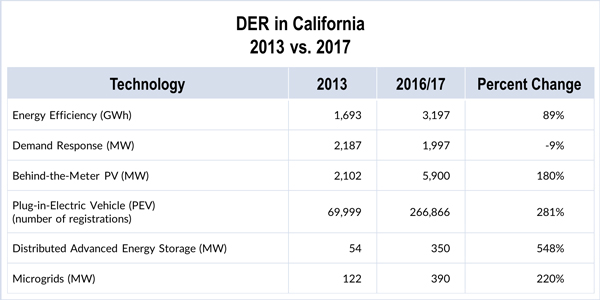By Jason Fordney
California could return to the conditions preceding the energy crisis of the early 2000s if the transition to fragmented decision-making and electricity procurement is not managed correctly, the Public Utilities Commission said in a report issued last week.
The report on California retail electricity choice, entitled “An Evaluation of Regulatory Framework Options for an Evolving Electricity Market,” is meant to guide the discussion as the CPUC, state lawmakers and other entities work to manage the disaggregation of energy procurement from traditional utilities to an environment with much more residential rooftop solar, community choice aggregators (CCAs) and private electricity sellers through the state’s Direct Access program, which allows nonresidential customers to purchase directly from a competitive supplier.
According to the paper, decision-making around reliability, affordability and safety is splintering from central authorities such as the CPUC to multiple entities.
“In the last deregulation, we had a plan, however flawed,” the report says. “Now, we are deregulating electric markets through dozens of different decisions and legislative actions, but we do not have a plan. If we are not careful, we can drift into another crisis.”
The paper examines how electric delivery can remain reliable as the market fragments, particularly from the growth of CCAs. It expresses concerns about reliability, affordability and ability to decarbonize the electric system if the transition is not managed effectively.
During the energy crisis, market design flaws, insufficient monitoring and “gaming” by market participants caused price spikes, collapse of competitive suppliers and rolling outages. The state became the model for how not to manage electricity restructuring and received much attention, particularly regarding the artificial shortages created by the Enron energy trading firm.
Splintering Model
The current model was developed after the crisis, with load-serving entities required to demonstrate each year that they have contracted for adequate energy supply. The paper poses the question of whether there needs to be a single entity responsible for policymaking, implementation and enforcement.
It also explores how new technologies could be financed, how to reduce the use of fossil fuels such as natural gas and how to properly compensate utilities. It also asks whether there should be a state entity to manage “behind-the-meter” generation and other entities that are not under the jurisdiction of the CPUC, as well as evaluating other regulatory models that evolved in New York, Illinois, Texas and Great Britain.
“I think there are solutions to a lot of the potential problems, although there is not a single or a dominant design to target them,” CPUC President Michael Picker told RTO Insider last week. He added that some customer choice models are built around a particular technology such as rooftop solar, battery storage, demand response or natural gas fuel cells that can be obtained through small generator incentive programs.
“We have to do something to address the disaggregation of supply and the splintering of decision-making,” Picker said. About 13% of load across the state is provided through the Direct Access program to commercial and industrial customers.
It’s not the CPUC’s job to get in the way of CCA growth, Picker said, but “we do have to do something to respond to the growing disaggregation.”
CCAs Respond
The CPUC got pushback from CCAs in February when it approved an order implementing a registration process for them along with other changes to the regulatory structure. (See CCAs Oppose CPUC Decision, Process.)
In a statement Thursday, the California Community Choice Association said the CPUC report “wrongly asserts today’s energy system lacks regulation and adequate planning.”
“Highly regulated locally controlled CCAs were designed to help correct the problems from the energy crisis, and they are performing as intended — delivering reliable, affordable and clean energy to local customers, while exceeding the state’s [greenhouse gas] goals,” Executive Director Beth Vaughan said. “It is important to recognize in this report that other states use energy-choice program models that differ widely from those used by CCAs in California.” She said CCAs are committed to “reliability, affordability, decarbonization and social equity.”
The CPUC said the report is not meant to advocate specific policy actions but seeks instead to “jumpstart a conversation.” Comments on the report are due on June 4, which can be filed at customerchoice@cpuc.ca.gov, and the commission has also set up a webpage for the initiative.





